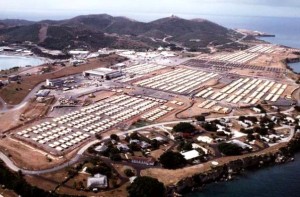Reflection: Ambiguity in Memories of Guantánamo Bay
National Dialogue and Traveling Exhibit
The story from our short study of Guantánamo Bay’s history that I found the most compelling is Janet Miller’s narrative in Memories of Guantánamo Bay, 1960-1962. What I find so striking is how incongruent her experience at the base is with my prior understanding of Guantánamo. How can a place that has witnessed so much pain and suffering also represent something akin to a tropical paradise for thousands of military families over the years?
Though I am frequently angered and disturbed by many other stories and images we have encountered in class, it is the uniqueness and otherworldliness of the part-suburban, part-militarized, and part-exotic landscape in Miller’s recollections that has helped me see the remarkable, ambivalent, and kaleidoscopic nature of this place.
Perhaps what most draws me to the ambiguity in Memories of Guantánamo Bay is what it suggests about our nation’s current relationship with the site. Guantánamo is so distant and unique that most of us know very little about it. It is this very distinctiveness that has made Guantánamo the ideal place for the U.S. government to turn to when dealing with truly exceptional situations.
Yet, it is also the complex nature of the site that has left so many Americans with their own uncertainty and ignorance about what has happened there. How could anyone go shopping or swimming at the beach within sight of a Cold War boundary that could have erupted in a third world war at any point? Similarly, how can thousands of refugees suffer or untried terrorist suspects be tortured by our government while we go about our daily lives as if nothing were happening?
By Robert Coleman, Public History Program, Arizona State University
Arizona State University is participating in the Guantánamo Public Memory Project‘s National Dialogue and Traveling Exhibit. Opening at NYU’s Kimmel Center for University Life Windows Gallery in December 2012 and traveling to 9 sites (and counting) across the country through at least 2014, the exhibit will explore GTMO’s history from US occupation in 1898 to today’s debates and visions for its future. The exhibit is being developed through a unique collaboration among a growing number of universities as a dialogue among their students, communities, and people with first-hand experience at GTMO.
One Comment to: Reflection: Ambiguity in Memories of Guantánamo Bay


June 8, 2012 4:40 pmRussell Watters wrote:
I lived in GTMO from 1970 – 1975 class of 75 W.T. Sampson high school. Thanks for showing the student side of life there!